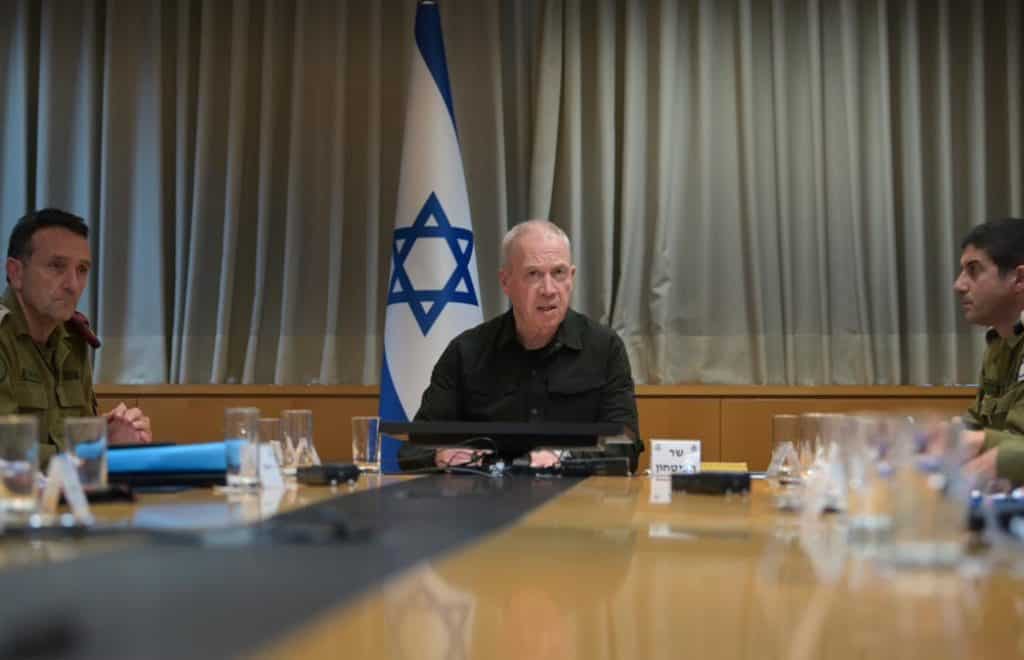
Israeli Minister of Defense Yoav Gallant held a strategic discussion with Israel Defense Forces (IDF) Chief of Staff Lieutenant General Herzi Halevi and other IDF officials, Gallant’s office said on August 29. The meeting comes as the IDF carries out an extensive operation in the northern West Bank aimed at uprooting various terrorist groups that have expanded their presence in several urban areas. Gallant’s meeting also took place as the chief of staff of Iran’s armed forces, Major General Mohammed Bagheri, threatened Israel on August 29.
Gallant is focused on the importance of returning Israelis to northern communities that were evacuated due to the Hezbollah threat in October 2023. Israel also evacuated several dozen southern communities near Gaza in the wake of Hamas’s October 7 attack. Some of those communities had been devastated due to the attack, while others were cleared so the IDF could deploy five divisions of tanks and infantry around Gaza to prepare the ground offensive.
In northern Israel, Hezbollah soon began launching rockets, drones, and missiles at Israel in October, and Israeli leaders took the decision to evacuate communities within several miles of the border, sending some 80,000 people into hotels and other temporary residences. The city of Kiryat Shmona became a ghost town.
While residents have returned to some southern communities, particularly the city of Sderot on the border with Gaza, the north remains mostly evacuated. There are exceptions, however. The Druze and Arab communities near the border did not evacuate. In addition, as Hezbollah expanded its rocket attacks to target the Golan and communities such as Shamir and Ayalet HaShachar in the Huleh valley, Israel did not increase its evacuation orders. Nevertheless, around 60,000 people remain evacuated, including around 14,000 children whose school year begins on September 1 away from home.
“Our mission on the northern front still lies ahead—that is ensuring the safe return of the northern communities to their homes. In order to achieve this, we must widen the goals of this war. I will raise this matter before the prime minister and the cabinet,” Gallant said on August 29. He said the current goals of the war, which are dismantling Hamas’ military and governing capabilities and returning the hostages from Gaza, should include the return of the residents to the north.
Gallant made several points in his discussion on August 29. According to a statement from his office, he said that Israel’s military operations in Gaza “have enabled the return of most of the southern communities to their homes.” Gallant traveled to southern Gaza on August 21 and noted that Hamas’s Rafah Brigade had been defeated. This leaves the group with only a few organized units, primarily in central Gaza.
Gallant also noted that the elimination of Muhammed Deif, the military leader of Hamas in Gaza, was an important milestone. “Most of the Hamas brigades and battalions have been defeated,” he said. Hamas began the war with 24 battalions, and the IDF has in the past said that most of them have been dismantled. It’s not clear how many of them Hamas has reconstituted as it returned to some areas such as Khan Younis and Shati in northern Gaza, for instance.
The IDF has now turned to focus on the northern front, the West Bank, and wider Iranian threats. “We are fighting against Iran, Hezbollah, and the Houthis. A month ago, the IDF eliminated Hezbollah’s Military Chief Muchsan, and earlier this week, the IDF thwarted a significant attack against citizens in both the center and north of Israel,” Gallant said.
Israel characterizes the current war as taking place on seven fronts. These include threats from Gaza, the West Bank, Lebanon, Iran, Iraq, Yemen, and Syria. Gallant’s desire to expand the war’s goals to return Israelis to the north is part of a larger picture focusing on Hezbollah and other Iranian proxy threats.
As part of the focus on the north, Israeli Prime Minister Benjamin Netanyahu met with soldiers of the IDF’s Golani Brigade on August 28. Netanyahu referenced Israel’s preemptive strikes on Hezbollah rocket launchers in the early hours of August 26, noting it was a success.
“I said the simple truth: It is not the end of the story. When will that be? Only when we are able to restore security and the residents safely to their homes,” Netanyahu said. He called the return of residents to their homes a “national goal of the highest order.” Taken together, Gallant’s strategic discussion and the visit by Netanyahu to the north illustrate that Israel’s top officials shifting focus to the northern front.







